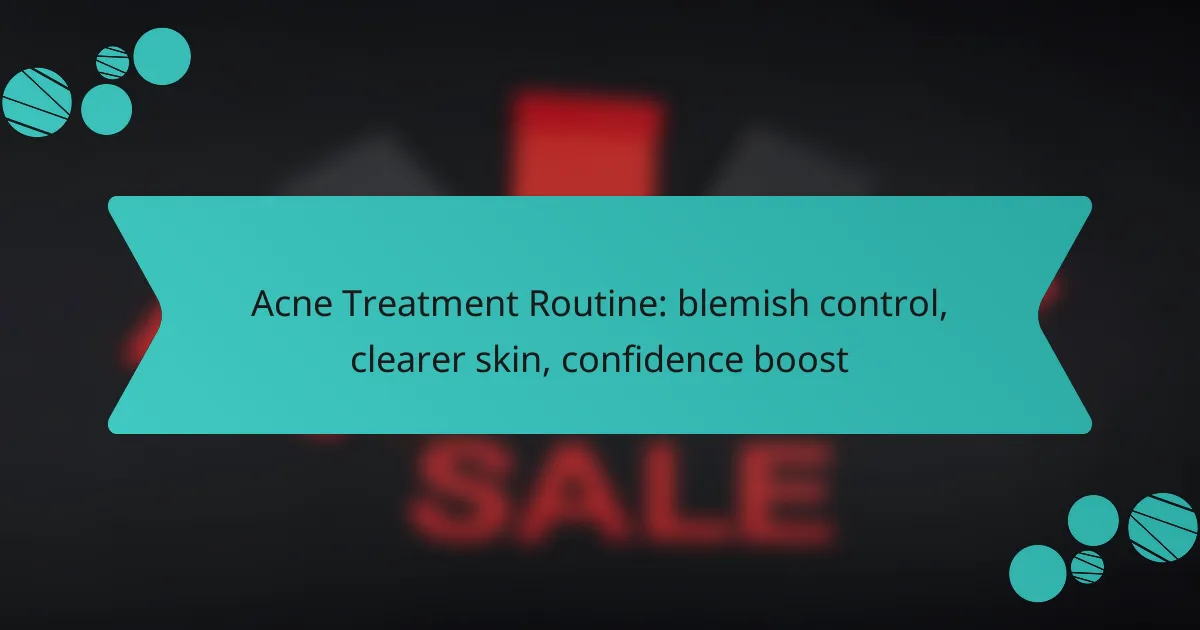Achieving clearer skin and boosting confidence starts with an effective acne treatment routine that emphasizes consistent application of targeted ingredients. By incorporating daily cleansing, moisturizing, and spot treatments, individuals can significantly improve blemish control and overall skin health. A well-structured regimen not only enhances appearance but also fosters a positive self-image, empowering individuals to face the world with renewed confidence.
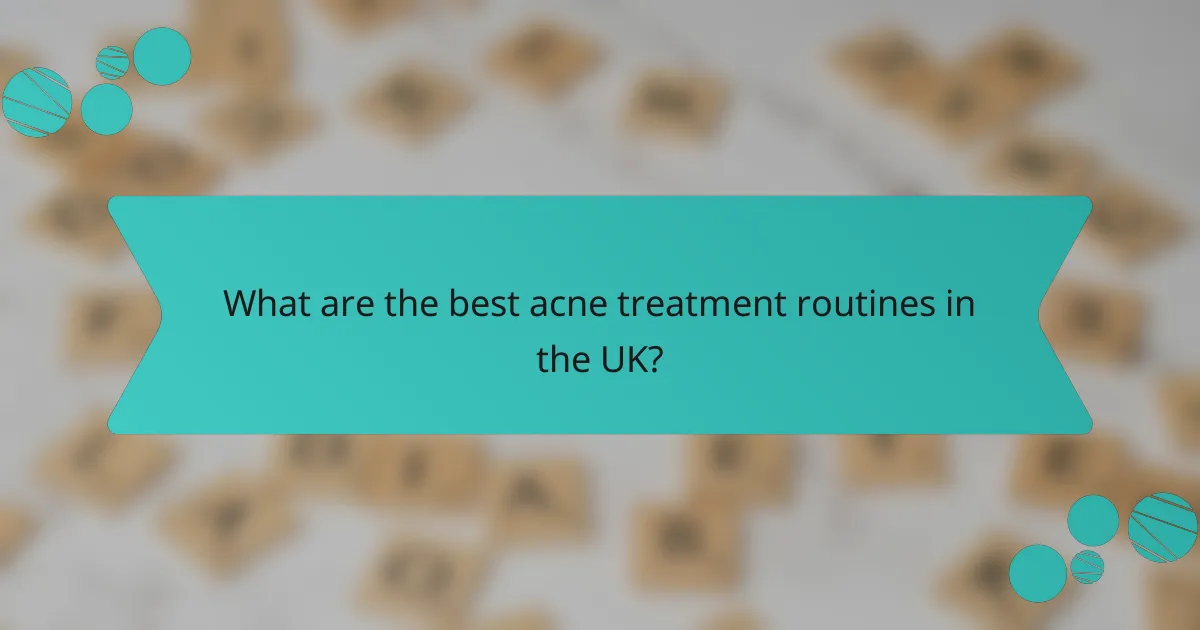
What are the best acne treatment routines in the UK?
The best acne treatment routines in the UK focus on effective ingredients and consistent application to achieve clearer skin and boost confidence. A combination of daily cleansing, moisturizing, spot treatments, exfoliation, and retinoids can significantly improve blemish control.
Daily cleansing with salicylic acid
Daily cleansing with salicylic acid helps to unclog pores and reduce acne breakouts. This beta hydroxy acid penetrates the skin to dissolve excess oil and dead skin cells, making it a popular choice for oily and acne-prone skin types.
For optimal results, use a cleanser containing 0.5% to 2% salicylic acid, applying it twice daily. Avoid harsh scrubbing, as it can irritate the skin and exacerbate acne.
Moisturizing with non-comedogenic products
Moisturizing is essential for maintaining skin hydration, even for those with oily skin. Non-comedogenic products are formulated to avoid clogging pores, which can lead to more breakouts.
Look for lightweight, oil-free moisturizers containing ingredients like glycerin or hyaluronic acid. Apply moisturizer daily after cleansing to keep the skin balanced and prevent dryness.
Spot treatments with benzoyl peroxide
Spot treatments with benzoyl peroxide are effective for targeting individual blemishes. This ingredient works by killing acne-causing bacteria and reducing inflammation.
Use a spot treatment containing 2.5% to 10% benzoyl peroxide directly on blemishes. Start with a lower concentration to assess skin tolerance, applying it once or twice daily as needed.
Regular exfoliation with alpha hydroxy acids
Regular exfoliation with alpha hydroxy acids (AHAs) can enhance skin texture and promote cell turnover. AHAs, such as glycolic acid, help to remove dead skin cells and prevent clogged pores.
Incorporate exfoliation into your routine 1-3 times a week, depending on your skin’s sensitivity. Choose products with 5% to 10% AHA concentration for effective results without irritation.
Incorporating retinoids for skin renewal
Incorporating retinoids into your skincare routine promotes skin renewal and helps prevent future breakouts. Retinoids, derived from vitamin A, enhance cell turnover and reduce the appearance of acne scars.
Start with a low concentration retinoid product, applying it at night to minimize irritation. Gradually increase usage to every other night as your skin adapts, aiming for long-term benefits in skin clarity and texture.

How can I control blemishes effectively?
Controlling blemishes effectively involves using targeted treatments and maintaining a consistent skincare routine. These strategies can help reduce breakouts and promote clearer skin over time.
Using targeted treatments for active breakouts
Targeted treatments are essential for addressing active breakouts. Ingredients like benzoyl peroxide, salicylic acid, and tea tree oil can effectively reduce inflammation and kill acne-causing bacteria. Apply these treatments directly to blemishes for the best results.
When choosing a product, look for formulations that suit your skin type. For example, those with oily skin might benefit from gel-based treatments, while cream-based options may be better for dry skin. Always perform a patch test to avoid adverse reactions.
Implementing a consistent skincare schedule
A consistent skincare schedule is crucial for controlling blemishes. Aim to cleanse your face twice daily, followed by a suitable toner and moisturizer. This routine helps remove excess oil and dirt, preventing clogged pores.
Consider incorporating exfoliation into your routine 1-2 times a week to remove dead skin cells. Use gentle exfoliants to avoid irritation. Additionally, always apply sunscreen during the day to protect your skin from UV damage, which can exacerbate acne.

What are the benefits of a clear skin routine?
A clear skin routine offers numerous advantages, including enhanced skin health, improved appearance, and a boost in overall confidence. By consistently following a regimen tailored to blemish control, individuals can achieve clearer skin and enjoy the psychological benefits that come with it.
Improved skin texture and tone
Implementing a clear skin routine can significantly enhance skin texture and tone. Regular cleansing, exfoliating, and moisturizing help remove dead skin cells and promote cell turnover, leading to smoother skin. Incorporating products with ingredients like salicylic acid or glycolic acid can further refine skin texture by targeting blemishes and uneven pigmentation.
To maintain optimal skin texture, consider using a gentle exfoliant 1-2 times a week and a daily moisturizer suited for your skin type. Avoid harsh scrubs that can irritate the skin, and opt for non-comedogenic products to prevent clogged pores.
Increased confidence and self-esteem
A clear skin routine can lead to a noticeable increase in confidence and self-esteem. When individuals feel good about their skin, they are more likely to engage socially and express themselves freely. Clearer skin can reduce the need for heavy makeup, allowing for a more natural appearance that many find empowering.
To boost confidence further, consider documenting your skin journey. Tracking progress with photos can provide motivation and a sense of achievement. Remember, consistency is key; sticking to your routine will yield the best results over time.
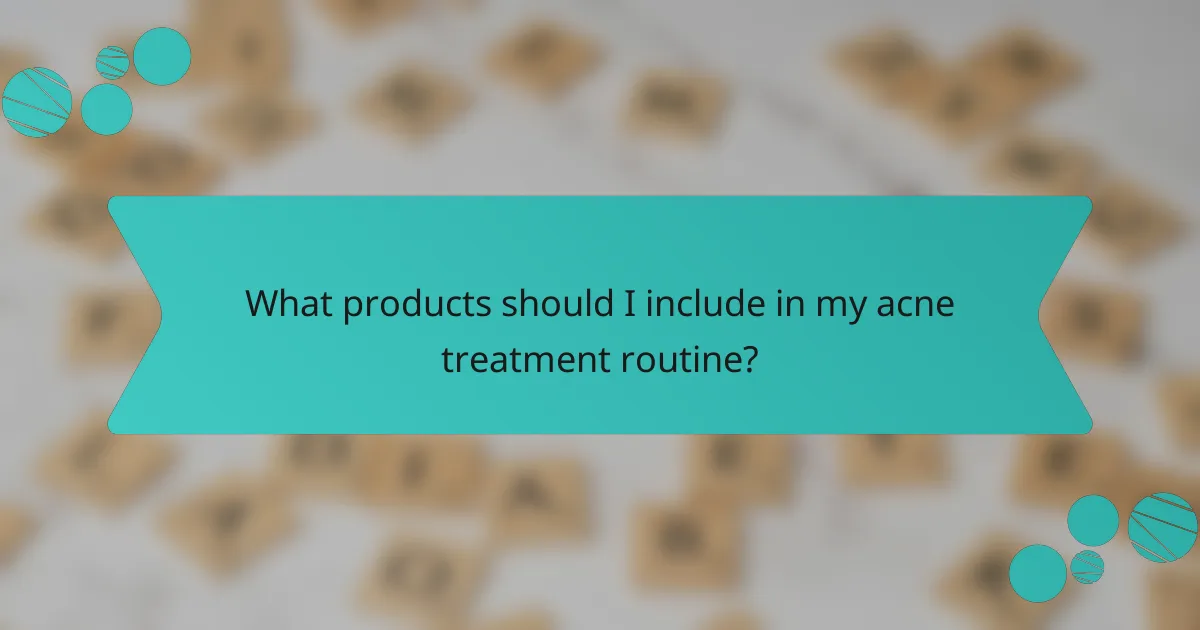
What products should I include in my acne treatment routine?
To effectively manage acne, include a combination of topical treatments, gentle cleansers, and oil-free moisturizers in your routine. These products work together to reduce blemishes, prevent breakouts, and promote clearer skin.
Topical treatments like Differin and La Roche-Posay
Topical treatments such as Differin (adapalene) and products from La Roche-Posay are essential for controlling acne. Differin is a retinoid that helps unclog pores and reduce inflammation, making it effective for both existing blemishes and preventing new ones.
La Roche-Posay offers a range of acne-fighting products, including gels and creams that contain salicylic acid or benzoyl peroxide. These ingredients help to exfoliate the skin and kill acne-causing bacteria. Always start with a patch test to avoid irritation.
Gentle cleansers such as Cetaphil
Using a gentle cleanser like Cetaphil is crucial for maintaining skin balance while treating acne. These cleansers effectively remove dirt and excess oil without stripping the skin of its natural moisture, which can exacerbate acne.
Look for formulations labeled as non-comedogenic, meaning they won’t clog pores. Cleanse your face twice daily to keep your skin clear and prevent breakouts. Avoid harsh scrubs, as they can irritate the skin and worsen acne.
Oil-free moisturizers like Neutrogena Hydro Boost
Incorporating an oil-free moisturizer, such as Neutrogena Hydro Boost, is vital for hydration without adding excess oil. These moisturizers often contain hyaluronic acid, which helps retain moisture in the skin while keeping it lightweight.
Moisturizing is essential even for oily skin types, as it helps maintain the skin barrier and prevents overproduction of oil. Apply your moisturizer after cleansing and treatment to lock in hydration and support your acne treatment routine.
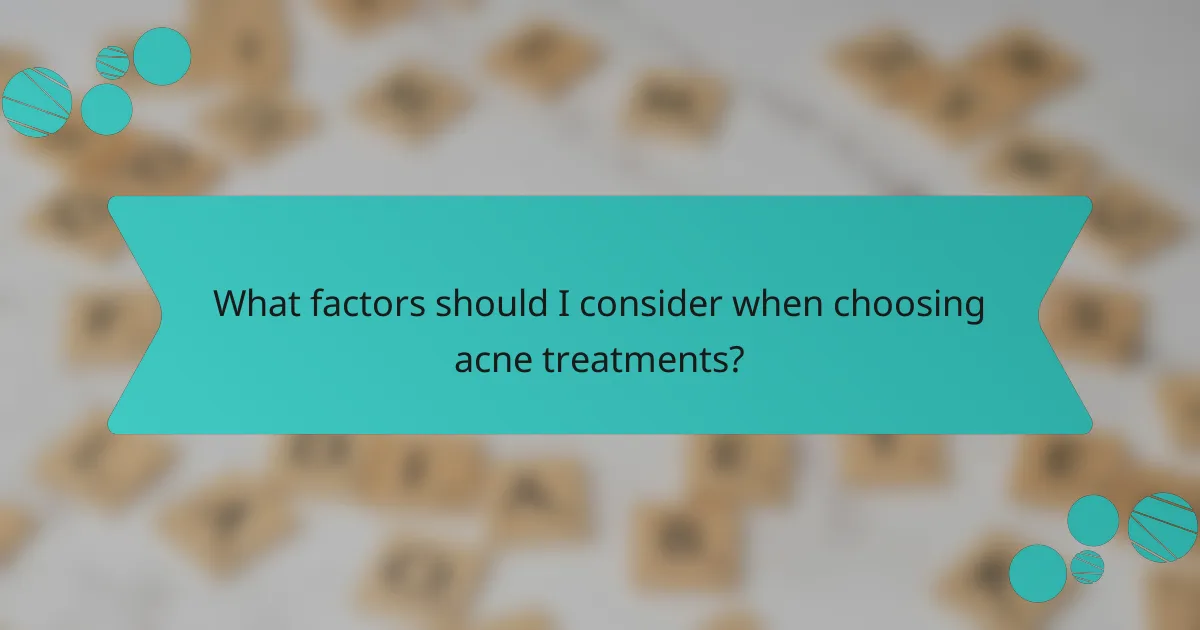
What factors should I consider when choosing acne treatments?
When selecting acne treatments, consider your skin type, sensitivity, and the effectiveness of active ingredients. These factors can significantly influence how well a treatment works for you and its potential side effects.
Skin type and sensitivity
Your skin type—whether it’s oily, dry, combination, or sensitive—plays a crucial role in determining the right acne treatment. For instance, oily skin may benefit from products containing salicylic acid, while dry skin might require gentler options like hydrating gels or creams.
Additionally, if you have sensitive skin, look for non-comedogenic and fragrance-free products to minimize irritation. Always perform a patch test before fully incorporating a new product into your routine to assess your skin’s reaction.
Ingredient effectiveness and compatibility
Familiarize yourself with common acne-fighting ingredients such as benzoyl peroxide, salicylic acid, and retinoids. Each ingredient works differently; for example, benzoyl peroxide targets bacteria, while salicylic acid exfoliates and unclogs pores.
Consider how these ingredients interact with each other and your skin. Avoid combining multiple strong actives, as this can lead to irritation. A simple routine with one or two key ingredients is often more effective and easier to manage.
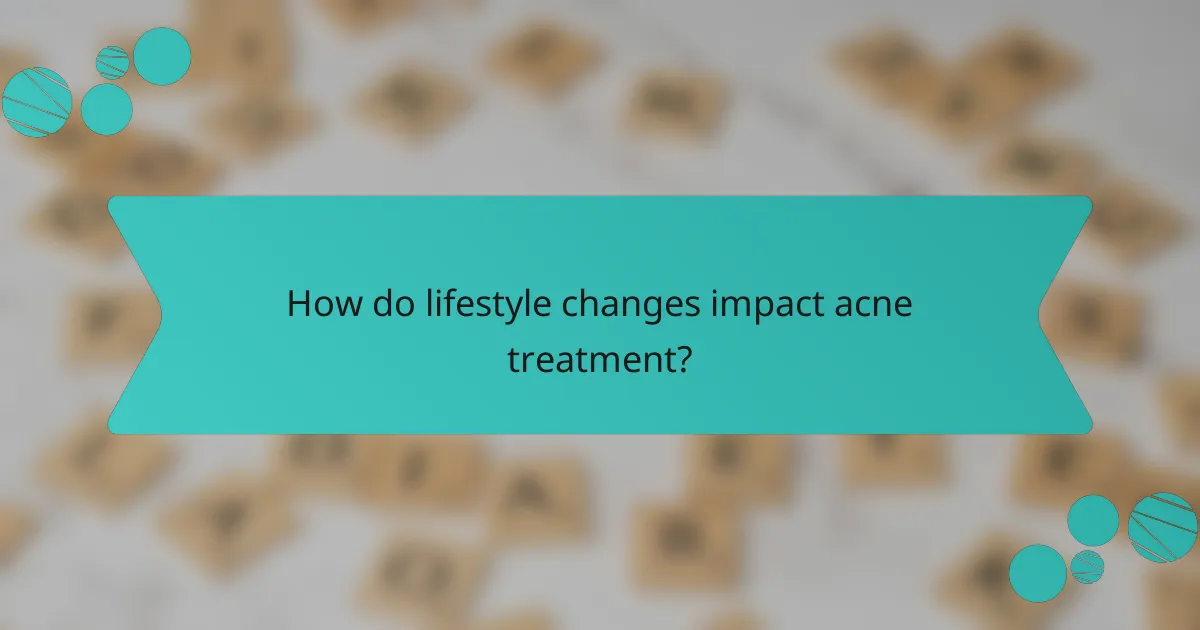
How do lifestyle changes impact acne treatment?
Lifestyle changes can significantly influence acne treatment by improving skin health and reducing breakouts. Factors such as diet, stress management, and sleep quality play crucial roles in skin clarity and overall well-being.
Dietary adjustments for clearer skin
Making dietary adjustments can lead to clearer skin by reducing inflammation and balancing hormones. Focus on incorporating whole foods, such as fruits, vegetables, lean proteins, and healthy fats, while minimizing processed foods and sugars.
Consider reducing dairy intake, as some studies suggest a link between dairy consumption and acne flare-ups. Instead, opt for plant-based alternatives like almond or oat milk, which may be less likely to trigger breakouts.
Staying hydrated is essential for maintaining skin health. Aim for at least eight 8-ounce glasses of water daily, and consider adding foods high in water content, such as cucumbers and watermelon, to your diet.
